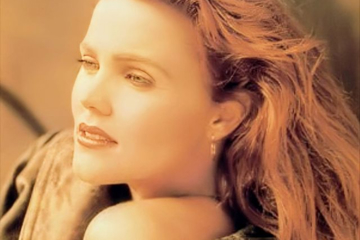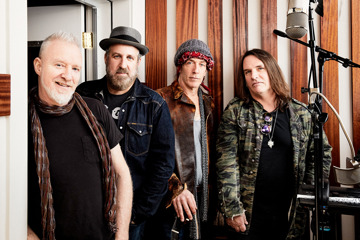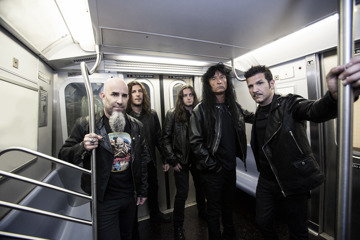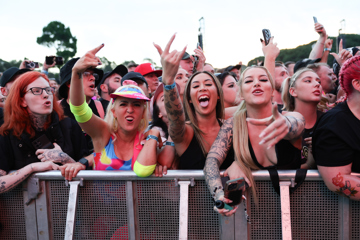'It Kind Of Blew Up A Little Bit': Sigur Rós On The Success Of Their Orchestral Tour Experiment
Described by Sigur Rós bassist Georg Holm as "almost an inevitable thing to happen," the lush experience of Sigur Rós' orchestral tour finally makes its way to Australia this month.

Sigur Rós (Credit: Supplied)

When Sigur Rós first coalesced in Reykjavík, Iceland back in 1994, none of its members likely could have assumed what the future would look like.
Initially consisting of guitarist and vocalist Jón Þór 'Jónsi' Birgisson, bassist Georg Hólm, and drummer Ágúst Ævar Gunnarsson, the group's earliest work, most notably, their 1997 debut Von, was a droning, dark ambient take on post-rock sweetened by the trademark falsetto vocals of Jónsi.
Welcoming multi-instrumentalist Kjartan Sveinsson the following year, it was in 1999 when the wider public began to cotton on to just what beautiful music Iceland was harbouring. Second album Ágætis Byrjun arrived to widespread acclaim, with the likes of Radiohead's Thom Yorke becoming a noted fan, and even inviting the group to open for the band in the early '00s.
As the decade continued, so too did Sigur Rós' lineup shift somewhat, and in turn, celebrated releases and the accompanying accolades arrived in due course.
Albums such as 2002's ( ) and 2005's Takk… became favourites; their unique singing language 'Vonlenska' (or 'Hopelandic') attracted attention across the board, and as the group toured to exotic locations such as Australia, their profile continued to grow.
By 2008, they were even featured in triple j's annual Hottest 100 countdown, with Gobbledigook reaching #93 that year. But as Sigur Rós continued to increase their profile and find themselves achieving more and more bucket-list items, they've never forgotten the sort of humility that accompanied their earliest days.
Don't miss a beat with our FREE daily newsletter
"I remember when we formed the band originally, I can't say that we had very clear goals on what we wanted to do," Hólm remembers via a Zoom call from Iceland. "It was mostly just that we enjoyed creating the music, and we enjoyed playing it.
"But I do remember there were a few things that we said to each other, and one of them was, 'We would love to be able to do this and only this, and just focus on doing this.' So I would say it would've been a very, very far, distant piece of fantasy if someone told us we would be touring Australia at some point.
"I don't think we would've believed it at that point," he adds. "But we've been lucky."
One could argue that it's actually Australia who has been lucky, with Sigur Rós having toured Australia on every album cycle since Takk…, and even adding a few additional visits and festival appearances along the way.
Most recently, they were here in 2022, their first visit since 2017, and arriving just in time for the release of their most recent album, 2023's Átta.
Now, though, they launch another Australian tour this week, albeit one with a difference. Instead of the standard lineup that accompanies their live shows, Sigur Rós will this time be accompanied by a 41-piece orchestra for what is fittingly dubbed their Orchestral Tour.
Alongside dates in Adelaide and Melbourne, they're also performing at the Sydney Opera House and Brisbane's QPAC Concert Hall as part of Vivid LIVE and Open Season, respectively.
Of course, for a band whose music is as sweeping, cinematic, and ethereal as Sigur Rós, they've always had orchestral leanings, but now, it's their first time embarking on such an undertaking on a grand scale.
"It was almost an inevitable thing to happen," Holm admits. "We always knew that at some point we would play with an orchestra. We have done this in the past, but it has been quite different. I mean, we've toured with a quartet and things like that, and we did Odin's Raven Magic years ago, but it was sort of a unique piece of music; it wasn't Sigur Rós' rock and roll music converted into an orchestra piece.
"We never really wanted to do the 'Sigur Rós and an orchestra show' thing. We never felt that would be authentic to us. We never wanted it to be the band in the front and then backed up by an orchestra. That just didn't feel right that we would do it that way."
However, listeners of the band's last record, Átta, would undeniably recognise an orchestral element to their work – largely thanks to the presence of the London Contemporary Orchestra on nine of its ten tracks. "We thought, 'Well, this is the record that probably needs an orchestra on tour with us," Holm recalls.
After a handful of shows with the London Contemporary Orchestra and conductor Robert Ames in 2023, it was – as the title of their 1999 album translates to – 'a good beginning,' but one that left them eager to repeat the experience.
"It just went so well, we enjoyed it so much," Holm adds. "Robert Ames, of course, kind of pulled everything together as well. Kjartan and his wife, María, went through all the songs with us, and we decided, 'What songs from outside of the new record would we like to play?'
"It was a test. We did a test and it worked really well, and we thought we should continue this, we should do more of these shows," Holm continues. "It kind of blew up a little bit. It became a little bit more than a few shows. I guess it's been two years or so of touring this show."
For anyone who has been lucky enough to witness an orchestral performance with any band, they would likely know there are two ways in which to make such an undertaking successful.
On one hand, there's the decision to have the orchestra serve as a supplement, with the musicians adding flourishes to the original songs, while the other involves the orchestra effectively becoming part of the band.
It's the latter that Holm says was the important focus for the band. It's the culmination of attempting to reimagine the songs in a new light and to provide an entirely unique experience for the audience.
"One of the first things that we said to each other is that we want this to be the Sigur Rós Orchestra, not Sigur Rós and an Orchestra," he explains. "Even though we are working with local orchestras everywhere, we still wanted to integrate ourselves into the orchestra.
"We wanted it to feel like a whole, where it wasn't the band in the front and some orchestra backing it up," he adds. "It should be one big piece of music, one big orchestra, and we are just a part of it – just cogs in the wheel."
The musical logistics of an orchestral tour can also be something to consider. While any performance would need scores composed for members of each orchestra, thus effectively ‘locking in’ the music that each musician would play, it does provide unique opportunities for members of Sigur Rós.
Where Holm might typically play a bassline in one song, the addition of an orchestra may therefore provide the chance to switch up the song, and perhaps play with less intensity as the violins swell.
"When we decided which songs, apart from the songs on the new record, that we wanted to play, we also decided we wanted to play them differently," Holm notes. "We don't want to just do the rock and roll band backed up by the orchestra, it should be the orchestral version of that song.
"Some of the songs were songs that we felt that we were never really able to play properly, and now with an orchestra, we have an opportunity to do that. It is quite difficult to piece this together, but we seem to have found a way of doing this really well.
"Even working with local orchestras, which was also important to us, rather than just touring around with an orchestra," he adds. "Working with local people, it just felt more real to us."
Of course, this doesn't mean that every performance will be a carbon copy of the last. Like using different brushes to create the same painting, each local orchestra contains myriad different musicians who approach their instruments on different nights.
It also means that there's a slight rigidity to the setlist, given it would be hard to drop the likes of Vaka or Hoppípolla at the last minute. Not least due to the outcry of diehard fans, but mainly because of the logistics of reorganising such a vast number of musicians ahead of the show.
"That is a nightmare, basically," Holm agrees. "But it happens quite often that we're playing a song and all of a sudden we would just look at each other and notice, 'This is much more quiet than it was yesterday,' or when we played it in this venue with this orchestra; ''This is completely different.'
"So we just have to adapt and adjust. Sometimes it's like, 'This is too quiet and I don't like it. I like to call it, 'Be wrong and strong,'" he explains. "Sometimes I just say, 'I'm going to be loud and just see if the orchestra follows me or not.' Sometimes it happens and sometimes it doesn't, so it is very interesting and it's quite alive at the time.
While the experience of Sigur Rós and an orchestra is a unique experience for the fans, it still remains a novel undertaking for the musicians at the core of the band itself. After all, to suddenly expand the band tenfold and to be performing as 'cogs in the wheel' changes the position of the group's members.
Though the band would be quick to claim it's about the entirety of the performers onstage, there's still a sense of seniority that they command, with their original musicianship helping to direct the flow as much as Ames' conducting.
"It was very scary in the beginning to think like, 'Okay, we're going to be playing these songs that we've been playing for years with, with 41 people on stage playing the same song, and I'm going to have to be 100% because nothing can go wrong,'" notes Holm.
"But at the same time, it's been very interesting to find out that you can sometimes hide a little bit in the orchestra. Of course, you make mistakes and things like that, and you're just going to say, 'Well, no one noticed that.'
"It's such a fine balancing act, though, because you want it to be a Sigur Rós show, but you also want it to be an orchestral show. One of the things that we also discussed a lot before we started this show was that usually we have a lot of visual screens behind us, and there's a lot of lights and things like that.
"So, what do we do in this situation? We have 45 people on stage," he notes. "We decided we would keep it as minimal as possible. We just want people to enjoy looking at this big orchestra playing the songs and hopefully enjoy the music as well."
With so much time spent in Australia over the years though, local fans are arguably gracious that Sigur Rós make a concerted effort to keep returning to our shores time and time again. But what is it about this country that connects with the group so much?
After all, emotional, ethereal music isn't exactly the sort of thing that Australian crowds are typically known to flock to, and while Sigur Rós' shows often feature moments of passion and intensity, it's far removed from the blistering rock that the country seems to pride itself on.
"That's a good question," Holm says. "We definitely love coming to Australia, that's for sure. It's just about as far away from home as we can get, of course, but I think we feel a connection.
"We have a loyal fanbase there, that's for sure, and we always enjoy coming there. It's a beautiful country, and it's a privilege to be able to come and visit, as far away as it is, to be able to come and play, and have people come to see our shows."
For Holm, Australia serves as something of a reminder about why Sigur Rós do what they do. It's not that Australia is exactly inspiring their music, or at the back of their mind with each and every show, but it's representative of what their music is capable of, for both fan and band.
"I had one of the most profound moments of my life, actually, right in Australia," Holm shares. "I remember, we were on tour, we'd been touring for a very long time, and I was feeling absolutely exhausted.
"It's one of those moments where your brain just keeps trying to tell you that you're doing the wrong thing, and you're like, 'What am I doing? Why am I so exhausted and travelling so much?' and basically just complaining. I had this moment where I walked into the hotel room and I opened the curtains of the hotel room. My view – not in the far distance, but still some distance – was the Sydney Opera House.
"I stood there and I was looking at it and I just thought, 'What am I complaining about?'" he remembers. "'This is absolutely fantastic,' I thought. 'What a privileged thing to be able to do.' It was one of those moments where I just stopped complaining completely."
Sigur Rós launch their Australian tour on May 16th, with tickets to all shows on sale now.
Sigur Rós
Australian Orchestral Tour 2025
Friday, May 16th – AEC Theatre, Adelaide, SA - NEW SHOW
Saturday, May 17th – AEC Theatre, Adelaide, SA - SOLD OUT
Monday, May 19th – Hamer Hall, Melbourne, VIC - SOLD OUT
Tuesday, May 20th – Hamer Hall, Melbourne, VIC - SOLD OUT
Wednesday, May 21st – Palais Theatre, Melbourne, VIC - NEW SHOW
Friday, May 23rd – Sydney Opera House, Sydney, NSW - NEW SHOW
Saturday, May 24 – Sydney Opera House, Sydney, NSW - NEW SHOW
Sunday, May 25th – Sydney Opera House, Sydney, NSW - NEW SHOW
Tuesday, May 27th – QPAC Concert Hall, Brisbane, QLD - SOLD OUT
Wednesday, May 28th – QPAC Concert Hall, Brisbane, QLD - NEW SHOW







